 |
 |
|
 |
New state highway map guides travelers in Minnesota |
 |
 |
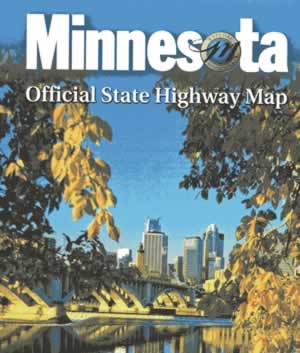 |
|
Minnesota’s new state highway map earned second place honors in April for design and usability at the annual meeting of the annual Geospatial Information Systems for Transportation Symposium. |
Minnesota’s state highway map, the faithful companion of many travelers, re-appears this spring featuring a guide to many of the state’s natural attractions and geographic landmarks.
A new printing technique that uses random dot patterns instead of ruled dot screens, creates color patterns that are more even and eye-appealing, said Denny Brott, supervisor of the Geographic and Mapping Section in the Central Office.
The new map also uses larger and bolder typefaces and heavier lines to increase its readability, he said.
Minnesota’s map earned second place honors for design and usability at the annual meeting of the annual Geospatial Information Systems for Transportation Symposium held April in Lincoln, Neb.
The 2005-06 map is also the first to appear simultaneously on the World Wide Web and in print. The 2003-04 version of the map issued in the spring was posted to the Web in November of that year.
The 2005-06 map includes a guide to some of Minnesota ’s most striking natural landscape features: the cliffs of Blue Mound State Park near Luverne, the rocky gorge of the St. Croix River near Taylors Falls and the new Big Bog recreational area east of Red Lake in northwestern Minnesota.
Other sections of the map include detailed maps of the Twin Cities metropolitan area and major cities in Greater Minnesota as well as indices to locate cities, counties, state parks and historical sites. The map also lists cities served by regularly scheduled passenger air, rail and bus service.
The map carries messages urging motorists to use extra care in highway work zones and to use the state’s automated road and weather reporting service by calling 5-1-1 or going to 511mn.org on the Internet.
 |
Jim Byerly, Mn/DOT Library, displays the new highway map and several earlier editions. The library has a highway map collection dating from 1914. Photo by David Gonzalez |
The departments of Transportation and Administration and Explore Minnesota Tourism produce the map biannually.
Printed versions of the map are available without cost from travel information centers and Mn/DOT offices throughout the state.
To access the Web version of the map, go to www.dot.state.mn.us and then click on the “Getting Around” button.
“The new state highway map and the 5-1-1 system can help tourists, business travelers, commuters and other motorists find their destinations easily and safely,” said Lt. Gov./Transportation Commissioner Carol Molnau.
By Craig Wilkins
|
back

|
 |
MnPASS I-394 Express Lanes are ready to go |
 |
 |
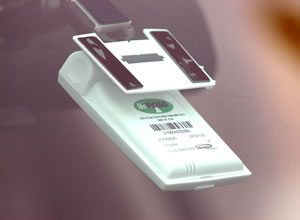 |
|
The MnPASS I-394 Express Lanes will open May 16. Motorists who choose to may lease a transponder like the one pictured here and prepay to use the new toll lanes. Photo by David Gonzalez
|
Mn/DOT will celebrate the opening of the MnPASS Interstate 394 Express Lanes on Monday, May 16 in Minnetonka.
Gov. Tim Pawlenty and Lt. Gov./Commissioner Carol Molnau are scheduled to be on hand to lead Minnesota into a new era in Minnesota transportation toll roads.
The MnPASS I-394 Express Lanes are located on one of the Metro District’s busier corridors. Up to 150,000 vehicles a day drive on some portion of the I-394 roadway that runs from downtown Minneapolis to the western suburbs in Hennepin County.
The 11-mile stretch of roadway has been home to one of two high occupancy vehicle lanes in the Twin Cities metro area. (The other is on I-35W from Richfield to the Burnsville.) Built in 1992, the I-394 HOV lane has two segments: a reversible section about three miles long and a diamond lane section separated from general traffic by a skip stripe that is eight miles long.
The new toll operation will be entirely electronic. Motorists will subscribe to the system and establish pre-paid accounts. They will lease transponders, small radio transmitters that interact with overhead antennas in the corridor. As motorists drive through the lane, their toll automatically will be deducted from their accounts. The I-394 Express Lane will continue to be free of charge to transit, car pools and motorcycles.
The MnPASS Service Center, located in the Mn/DOT facility in Golden Valley, had orders for more than 3,300 transponders as of May 9. The transponders were mailed to subscribers this week.
By Kevin Gutknecht
|
back

|
 |
State bike plan outlines key initiatives for next 25 years |
 |
 |
The Office of Transit’s Mn/DOT Bicycle Modal Plan, adopted by Commissioner’s Staff in January, is now available on the Web.
In developing the plan, a steering committee of Mn/DOT and external representatives looked at state and federal laws related to bicycle transportation and recent trends that pose challenges to bicycling and walking in Minnesota.
“The Bike Modal Plan was designed to bring greater safety and consistency to Mn/DOT operations involving bicycles,” said Jim Dustrude, Office of Transit. “It does this by prioritizing investments needed to achieve service and facility performance levels identified in the Minnesota Statewide Transportation Plan, as do other modal plans within the department.”
The plan outlines three key initiatives that will help Mn/DOT implement state policy for bicycles and pedestrians during the next 25 years:
“Safely accommodating bicycles in Mn/DOT’s planning and programming will help improve travel choices, safety and convenience for bicyclists and all road users,” said Randy Halvorson, Program Management Division director. “It will help provide a smarter, safer and more efficient transportation system overall.”
For more information, contact Darryl Anderson at 651/297-2136. The Mn/DOT Bicycle Modal Plan is also available online at http://www.dot.state.mn.us/transit/bikeplan.html.
By Donna Lindberg
|
back

|
 |
Minnesota ‘pedals’ bike safety |
 |
 |
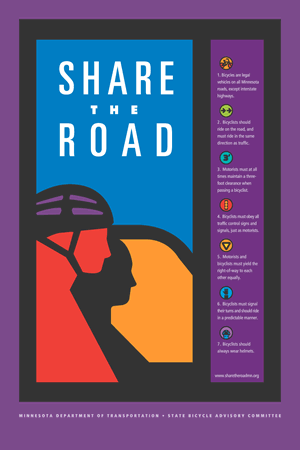 |
“Share the Road” is Minnesota’s new bicycle safety education program. |
If you're a bicyclist, May could very well be the month for you.
Not only is May National Bicycle Month, the third week in May is designated as Bike to Work Week. And now, Gov. Pawlenty has proclaimed May 15-21, 2005 as Bike Safely to Work Week in Minnesota.
Lt. Gov./Commissioner Carol Molnau will read a proclamation from the governor and welcome participants to a Bike Safely to Work Day news conference at the Transportation Building at 8 a.m. on May 19. Department of Public Safety Commissioner Michael Campion will also speak, as will St. Paul Mayor Randy Kelly. David LaPorte, University of Minnesota professor and bicycling enthusiast, will act as master of ceremonies. This event and other events in St. Paul, Minneapolis and Rochester will kick off Minnesota’s new bicycle safety education program “Share the Road.”
“The goal of the Share the Road program is to educate bicyclists as well as motorists about how they can share the road safely,” said Molnau. “The program contributes to the Pawlenty-Molnau administration’s goal of improving safety on Minnesota roads.”
Mn/DOT and the State Bicycle Advisory Committee have partnered on this effort. SBAC members include state agencies such as Public Safety and Health and also include citizen representatives.
The “Share the Road” slogan is also used by other states to promote bike safety. The slogan also appears on federal and Minnesota Manual of Uniform Traffic Control Devices signs currently on some local roads under a graphic of a bike and motor vehicle moving side by side. The slogan is based on the recognition that bicyclists and motorists are equally responsible for bicycle safety.
The cause of bicycle and motor vehicle crashes is attributed to behaviors such as ignoring traffic signals or inattention. But the primary factor is failure to yield the right-of-way. By following the seven rules of the road dictated by Minnesota statutes http://www.sharetheroadmn.org/rules.html, the potential for deadly bicycle/motor-vehicle crashes could be reduced.
“Bicyclists have the same rights and responsibilities as motorists, but increased awareness is also important,” said Mary Nelsestuen, SBAC chair. “Motorists must be aware of bicyclists and bicyclists must understand motorists can’t always see them.”
Bike Safely to Work Day and the Share the Road bicycle safety education program complement the governor’s "Year of Fitness in Minnesota" program intended to improve the health and well-being of Minnesotans through increased physical activity.
“Biking to work, school and other activities is a healthy, environmentally friendly way to travel,” said Darryl Anderson, state bicycle coordinator, Office of Transit. “The 'Share the Road' program will also help make bicycle for commuting or recreation safer and more fun.”
On May 19, snacks and beverages will be provided to all St. Paul Bike Safely to Work Day riders; biking-related booths will be set up on the plaza in front of the Transportation Building. Also at the event, Shimano and Bicycling Magazine will present 50 new bicycles to winners of a national essay competition about the benefits of bicycle commuting. The Twin Cities area is one of 10 locations nationwide taking part in the competition. Bicycle winners will take part in a ride around the Capitol after the event.
Bike Safely to Work Day ride routes and maps and “Share the Road” bike safety education information are available on the Web at www.sharetheroadmn.org.
By Donna Lindberg
|
back

|
 |
Researchers share findings during annual Transportation Research Conference |
 |
 |
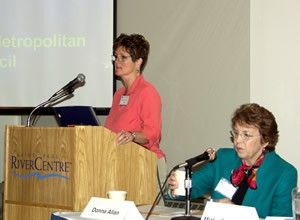 |
|
Michelle Gutzmann, Office of Transit, addresses a workshop on transit issues at the Transportation Research Conference in April. At right is Donna Allan, director of Transit. Photo by Amy Friebe |
Government officials, researchers and practitioners from several fields shared their knowledge and know-how during the annual Transportation Research Conference held April 26-27 in St. Paul.
Conference participants examined topics ranging from the ramifications of transportation mega-projects such as the $15 billion “Big Dig” highway project in Boston to finding ways to improve transit service in rural areas of Minnesota.
The Center for Transportation Studies at the University of Minnesota sponsors the annual conference.
Participants included researchers, policy-makers and practitioners from the Legislature, universities, government agencies and consulting firms, said Gina Bass, education and outreach manager with CTS.
Conference-goers addressed findings and potential solutions to scores of transportation-related challenges. Issues examined include ways to improve highway traffic safety, manage congestion and engage the public in the project decision-making process.
Jan Ekern, partnership coordinator with the Office of Maintenance, moderated a workshop on public involvement in planning transportation projects. The panelists cited key moments in project planning when public involvement sparked new ways to address problems and issues.
Biz Colburn, a planning consultant with HNTB, Inc., Minneapolis , said a suggestion from a member of the public made during a public hearing on rebuilding Hwy 10 in Detroit Lakes resulted in a major change in the project.
The citizen, Colburn said, suggested moving the railroad tracks that parallel the highway about 100 feet to the north, allowing room for a frontage road. Planners, she said, had not considered that option.
The suggestion was adopted, allowing a design that provides frontage road, reduces at-grade rail crossings and creates an underpass for the city’s main north-south traffic corridor.
Donna Allan, director, Office of Transit, moderated a workshop panel that examined research focused on a more coordinated use of existing resources to provide transit services.
The panel presented findings on the need to improve transit service coordination, especially in Greater Minnesota. Panelists said, for example, that many social service agencies provide transit services for clients but are not part of existing transit networks.
Allan said the panelists presented research findings on community-based transit operations and changing user needs such as transporting social service clients, serving foreign-born populations and providing transit services to pupils.
“The workshop allowed us to learn about research findings and best practices that we can use in our operations and planning to improve the effectiveness and coordination of public transit services statewide,” she said.
By Craig Wilkins
|
back

|
 |
Crash survivor expresses thanks for quick-acting Metro employee |
 |
 |
An Oakdale resident who was saved from possibly burning to death in her crashed mini-van by a quick-acting Mn/DOT employee wants her gratitude to become public.
Desiree Patterson, who lives on Hadley Avenue just a few blocks from the Metro District’s Oakdale shop, was trapped in her van following a Feb.1 collision with a parcel delivery truck in Oakdale on Hwy 5.
Steve Narusiewicz, a transportation generalist at Oakdale, was just starting his maintenance patrol route when he came upon the scene just moments after the crash.
When he saw bystanders throwing snow on the smoking engine compartment, Narusiewicz grabbed his pick-up’s fire extinguisher and sprayed the van just as the engine compartment caught fire.
Patterson had to be cut out of the car by the Lake Elmo Fire Department. Her vehicle, a 2005 Dodge Caravan, was destroyed.
The mother of three suffered a broken foot and a broken hand and is still recovering from her injuries.
A 25-year veteran at Metro, Narusiewicz has seen a lot of crashes, car fires and other mishaps. He said, however, this was one of the few times he had talked with a person involved after the incident occurred.
Patterson called to thank Narusiewicz a month after the crash; several weeks later she called the Metro District headquarters to praise his actions.
“I’ve been busy recovering and taking care of our kids, but I really wanted to make sure that Steve and the other Mn/DOT people know how grateful I am,” Patterson said.
By Craig Wilkins
|
back

|
 |
Tarnowski earns honors as first Roads Scholar graduate |
 |
 |
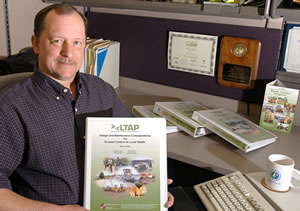 |
|
John Tarnowski, Maintenance Operations & Research, displays his Roads Scholar certificate. Photo by David Gonzalez |
The Center for Transportation Studies honored Mn/DOT’s John Tarnowski as the first graduate from its Roads Scholar Program.
Tarnowski, a project manager with Maintenance Operations & Research, earned the distinction by completing eight credits of course work related to highway construction and maintenance, traffic management, erosion control and equipment maintenance.
He earned his graduation certificate by participating in the spring and fall maintenance expos and by taking course work offered by the CTS’s Local Technical Assistance Program.
Started in 1992, LTAP provides training for local government transportation agencies. LTAP initiated the Roads Scholar program to foster skill development and recognition for those who complete the program.
Tarnowski received the award during the Spring Maintenance Expo held in St. Cloud on April 20-21.
Tarnowski’s career with Mn/DOT began in 1991 when he was a transportation generalist with the Metro District’s Mendota Heights truck station.
He joined MORE in 1998 as state coordinator of the Salt Solutions Program. He was promoted to project manager in 2000.
“I took these classes so that I could keep up with the people in the field and more easily relate to them when they propose ideas that might evolve into research projects,” he said.
By Craig Wilkins
|
back

|
 |
Thief River Falls crew, student work on better way to replace underbody plow edges |
 |
 |
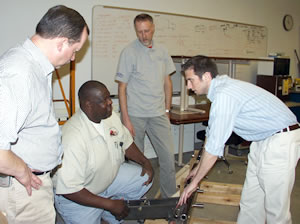 |
|
Michael Etheridge, a U of M mechanical engineering student, demonstrates his prototype to (from left) John Tarnowski, MORE; DeWayne Jones, maintenance supervisor at Golden Valley, and Dr.Craig Shankwitz, Intelligent Transportation Systems Institute. Photo by Amy Friebe, CTS
|
The need for a way to more easily change underbody plow edges began at the Thief River Falls truck station. The idea is becoming a reality and is nearing completion in a basement lab at the University of Minnesota in Minneapolis.
The journey from concept to reality began when Steve Huffnagle, maintenance supervisor at Thief River Falls, and his crew decided to bring up the idea at a Mn/DOT Operations Research/ U of M partnership meeting with district staff. Installing new underbody cutting edges is time-consuming and can be a potentially dangerous to workers. Changing the blade edges often requires two people because of their weight and positioning them correctly on the plow blade. (Only about 20 of Mn/DOT 150 truck stations have truck lifts.)
After the proposal to design a prototype was accepted during a research brainstorming session, Michael Etheridge, a mechanical engineering student at the university, decided to accept the challenge for a project for an honor’s class.
Funding was approved through Mn/DOT’s Maintenance Operations & Research/ New Technology Research and Equipment Committee.
Etheridge spent a year researching, designing and building a hydraulic changing system. His work was supported by Dr. Craig Shankwitz of the Intelligent Transportation Systems Institute at the U of M and John Tarnowski, Maintenance Operations & Research.
Etheridge recently displayed the prototype, known as the Quick Edge Underbody System, to staff from Mn/DOT, the university and the Center for Transportation Studies at the U of M.
The prototype uses four bolts to attach the ends of the blade; pins also support the blade. To attach or remove the blade, the pins are removed by hydraulic pressure and the bolts are easily reached for removal in a few minutes. By using remote controlled hydraulic device to perform most of the work, operators will be required to spend only a minimal amount of time under the truck.
“One of the great impacts this system would have includes the financial aspect,” Etheridge said. “This new design will not only shorten the time needed to do the job, most of all it can reduce the potential for injuries.”
The project’s next step involves field testing this fall and winter to determine how well the system works and how the new pin connections withstand the heavy stresses the underbody plow bears in operation, Tarnowski said.
By Lisa Yang
|
back

|
 |
Memorial service will be held May 21 for Metro District’s Karen King |
 |
 |
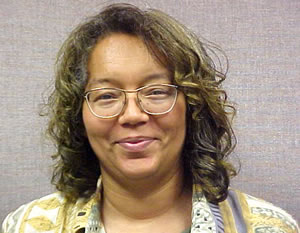 |
|
Karen King, programming unit supervisor, Metro District, died suddenly May 8. |
A memorial service will be held May 21 for Karen King, programming unit supervisor, Metro District, who died suddenly May 8 at her Roseville home. King joined Mn/DOT in 1993 in the Management Information Services Section in Central Office; she transferred to the Metro District in 1995.
At the time of her death, King supervised the district’s Development and Applications Unit. She was 54.
King will be interred in her native North Carolina.
The service will be held at noon at Mount Olivet Baptist Church, 451 Central Avenue, St. Paul . (The church is located one block north of Interstate 94 and three blocks east of Dale Street.)
“Karen was a champion of new ideas to automate processes and was always willing to share her expertise and that of her staff to promote automation throughout the department,” said Joe Delmore, the district’s MIS director and King’s supervisor.
|
back

|
 |
Molnau responds to editorial criticizing state highway workers |
 |
 |
Editor’s note: Lt. Gov./Commissioner Carol Molnau sent the following viewpoint to the St. Paul Pioneer Press in response to an editorial the paper published May 2: "If the choice is state prisoners or state employees, I'll take the cons.” This viewpoint was published in the May 15 St. Paul Pioneer Press.
I would like to thank Pioneer Press editorial writer Mark Yost for his endorsement of the Pawlenty Administration’s “Operation Clean Sweep," a program to use Sentencing-to-Service offenders to pick up highway litter. “Clean Sweep” is a low-cost way to clean up our state roadways by using offenders who are repaying their debt to society. Moreover, “Clean Sweep” makes sense by allowing skilled workers – both public employees and private contractors – to focus on priority highway construction and maintenance projects.
However, I am disappointed by Mr. Yost’s unfair, broad-brush criticism of state highway workers and his misunderstanding of the dangers inherent in highway work zones.
Last month, Mn/DOT announced a record-sized 2005 summer road construction program. In fact, Mn/DOT is starting or carrying over more than 200 construction projects around the state valued at about $1.7 billion.
Hardworking, trained and dedicated staff must keep these projects moving forward on schedule while managing ever-growing traffic volumes. When workers, construction activity, heavy equipment and large numbers of personal cars share the highway, conditions can be dangerous. As transportation commissioner, I have learned first-hand about the workers who risk their lives to keep projects moving and roadways safe.
Worker Memorial Day was recently observed to honor the 29 Mn/DOT employees who died in work-related accidents since 1960. The most recent fatality occurred last June when a senior transportation specialist with the Twin Cities Metro District was killed in a work zone truck accident.
From 2000 to 2003, more than 2,400 crashes occurred in highway work zones. The crashes resulted in 12 deaths and 1,250 injuries. Nearly all of the fatalities or injuries were suffered by motorists and their passengers, a reminder that motorists act in their own self-interest by driving safely in work zones. Mn/DOT’s safety slogan, “Work Zones. Pay Attention or Pay the Price,” urges motorists to use extra caution in work zones to avoid the costly price of vehicular damage, personal injury or worse.
Thousands of private and public sector construction professionals work hard – and often put their lives on the line – to build and maintain Minnesota’s transportation system, which is critical to our economy and quality of life. At the beginning of the largest highway construction season in state history it is inappropriate to make light of these workers and highway work zones.
Carol Molnau
Minnesota Lt. Governor and State Transportation Commissioner
|
back

|
 |
|
 |



